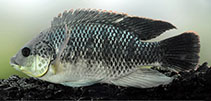| Family: |
Cichlidae (Cichlids), subfamily: Pseudocrenilabrinae |
| Max. size: |
40 cm SL (male/unsexed); max.weight: 300.0 g; max. reported age: 7 years |
| Environment: |
benthopelagic; freshwater; brackish; pH range: 6 - 9; dH range: 5 - 20; depth range 1 - 7 m, potamodromous |
| Distribution: |
Africa and Eurasia: South Morocco, Sahara, Niger-Benue system, rivers Senegal, Sassandra, Bandama, Boubo, Mé, Comoé, Bia, Ogun and Oshun, Volta system, Chad-Shari system (Ref. 5163), middle Congo River basin in the Ubangi, Uele (Ref. 55074), Itimbiri, Aruwimi (Ref. 55074, 106290), Lindi-Tshopo (Ref. 106290) and Wagenia Falls (Ref. 106245) in Democratic Republic of the Congo, Lakes Albert (Ref. 55074) and Turkana, Nile system and Jordan system (Ref. 5163). Several countries report adverse ecological impact after introduction. |
| Diagnosis: |
Dorsal spines (total): 13-16; Dorsal soft rays (total): 10-14; Anal spines: 3-3; Anal soft rays: 8-10. Diagnosis: A large, deep-bodied species with a narrow head and small strong jaws; generally has a bright red belly and prominent vertical barring (Ref. 118638). Upper profile of head not convex; lower pharyngeal bone about as long as broad, and with anterior lamella shorter than toothed area; median pharyngeal teeth not broadened; dorsal fin with 14-16 spines and 10-14 soft rays; 8-11 lower gillrakers; dark longitudinal band appears on flanks when agitated; no bifurcated dark vertical bars on flanks; dorsal and caudal fins not or feebly blotched (Ref. 53405). Body brownish-olivaceous with an iridescent blue sheen; lips bright green (Ref. 34290, 53405). Chest pinkish (Ref. 34290). Dorsal, caudal and anal fins brownish-olivaceous with yellow spots, dorsal and anal fins outlined by narrow orange band; "tilapian" spot large, extending from last spine to 4th soft ray and always bordered by yellow band (Ref. 34290, 53405). Specimens of 2-14 cm standard length with completely yellowish or greyish caudal fin without dots, but tend to develop a greyish caudal fin with dots of increasing size during development; above 14 cm standard length, this species has greyish caudal fins with dots on entire caudal fin (Ref. 57660). The sexes look very similar, although in a mated pair the male is usually larger (Ref. 118638). Difficult to distinguish reliably from Coptodon rendalli, but C. zillii can have a less-steep head profile and more prominent vertical bars; in East Africa, the tailfin of C. rendalli is often divided into a brown/grey upper part and red/yellowish lower part, whereas the tail of C. zillii is more uniform throughout (Ref. 118638).
Description: body rather deep, its depth about 55% of standard length; head profile straight, slightly oblique; outer jaw teeth bicuspid and non-spatulate, inner jaw teeth and posterior pharyngeal teeth tricuspid; micro-gillrakers present; scales cycloid (Ref. 53405).
Colouration: in life: ground colour brownish-olicaveous (Ref. 34290, 53405) with iridescent reflections on scales (Ref. 53405). Back and sides with 7-10 darker cross bars (Ref. 52307, 53405), depending on motivational state (Ref. 52307), and dark longitudinal band at level of lower lateral line (Ref. 53405). Second longitudinal band sometimes present along upper lateral line (Ref. 53405). Lips pale green (Ref. 34290, 53405). Dorsal, anal and caudal fins brownish-olivaceous and yellow-spotted; dorsal and anal fins often edged with orange (Ref. 34290, 53405). Iridescent green spots on head in sexually mature individuals (Ref. 53405). "Tilapian" spot large, extending from last spine to 4th soft ray and always bordered by yellow band (Ref. 34290, 53405). Opercular spot very distinct; caudal fin with an irregular network of darker lines; in fingerlings, black spots on dorsal and anal fins orange and caudal fin appears as vertically striped (Ref. 53405). When courting and breeding, individuals can have a copper to reddish flush on their sides; throat, belly and sometimes anterior part of caudal peduncle then show an intense red color (Ref. 52307). |
| Biology: |
Highly adaptable and tolerates varying water qualities (Ref. 52307); they are tolerant of a wide range of temperatures and salinities (Ref. 118638), even surviving marine conditions (Ref. 52307). Extended temperature range 6.5 - 42.5 °C, natural temperature range 10.5 - 36°C (Ref. 3). Occasionally form schools; mainly diurnal. Prefers shallow, vegetated areas (Ref. 4967). Fry are common in marginal vegetation and juveniles are found in the seasonal floodplain. Herbivorous (Ref. 52307), adults feed on leaves and stems of underwater plants as well as algae and vegetative detritus (Ref. 118638). A substrate spawner (Ref. 28714, 52307); male and female form pairs to rear the young (Ref. 118638); aggs and larvae are usually guarded in a pit dug in the mud (Ref. 118638). Parental care is very thorough and undertaken by both parties; large specimens may deposit 1000 eggs per spawn, preferably on hard surfaces; hatching occurs about 96 hours post spawning, and juveniles swim freely about 4-6 days later (Ref. 52307). Larvae develop in close association with substrate. |
| IUCN Red List Status: |
Least Concern (LC); Date assessed: 21 April 2019 Ref. (130435)
|
| Threat to humans: |
potential pest |
Source and more info: www.fishbase.org. For personal, classroom, and other internal use only. Not for publication.
